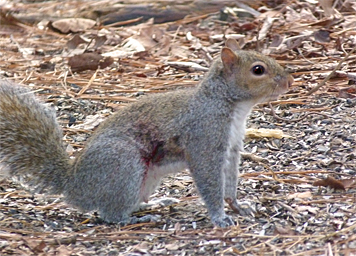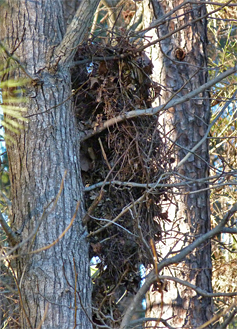
The squirrel above was at the bird feeders. The wound, which appears to be rather fresh, didn’t seem to bother the squirrel as it went about feeding. But I suppose that there’s not much the squirrel could do even if it did bother the varmint except lick the wound. I guess the question is, how did the squirrel get the injury?

If it were earlier in the year I might suggest that it was a warble that the squirrel kept scratching and biting until it burst. Warbles are caused by bot flies who lay their eggs on tree limbs, twigs, or in the nests of rodents. The warmth of the rodent’s body or the carbon dioxide from its breath stimulates the egg into hatching. The larva enters the squirrel’s body via a naturally occurring orifice or an existing wound. About a week later it forms a warble under the skin of the squirrel which becomes a large bulging pocket filled with the larva and, well, fluid. But, I think it may be too late in the season for it to be a burst warble.
There’s no real way to know how the squirrel may have gotten injured, but its not an uncommon sight to see squirrels with wounds as in the photo. This is the season when many fights over turf break out among our resident squirrels. The squirrels are building or refurbishing nests, fighting over food sources and presumably mates, and perhaps some of these wounds occur during battle.
From what I’ve read about them, the turf wars seldom result in permanent injury to the squirrels. But, from what I’ve seen and heard myself, the fights look and sound like more than simple little spats. There’s some serious fighting going on!
Last year around this time I watched as two squirrels went at it in the Red Wolf Enclosure, not a good idea. One of the squirrels fell from a tree and was nearly captured by the female wolf. The squirrel went back up the tree to finish what it had started. It, or the other combatant, once again fell from the tree, but this time the wolf inflicted a wound on the squirrel that was fatal.
Perhaps the squirrel in the photo at the top of this page was too preoccupied with territorial disputes to notice a Red-shouldered Hawk eyeing it. Maybe a feral cat took a swipe at the bushytail. A Barred Owl may have thought the squirrel deserved a go.
Squirrels are aerial acrobats for sure, but they can be very careless during the nesting season.
Found a squirrel, not a baby, keeps licking until he has bare spots. Have wiped the area. What should I do next
Update: I think you might be right about it being a warble. I saw the squirrel again today and he had something similar on his back – just a bare spot. His leg also seems like it’s doing better. I was able to spray some more colloidal silver on it. The reason I thought it was infected was because there was pus coming out – not sure if that’s normal for warble? I didn’t know we had warbles in California but after seeing him again today that looks like that might be what it is. Thanks again for your help!
That’s a possibility. Haven’t seen many of those here but could be. I live in California, so it’s a little warmer here. I purchased a small spray bottle of colloidal silver from Sovereign Silver online. It’s great. I’m friendly him…so while he’s eating nuts, avocado, apples – I was able to spray it on his leg, two days in a row. Most vets in my area won’t see wildlife but there is a wildlife vet, about an hour away. I took another sick squirrels there. The problem is – you have no control over what they do. I’m afraid they may just euthanize him. I’d rather give him a chance to survive.
I have a few wild squirrels that visit my patio for treats. I noticed one of them limping a little. He has a cut or bite on his leg that looks infected. He’s eating but I’m worried. I sprayed some colloidal silver on it – I read that it acts like a natural antibiotic. Not sure what else to do…will he be ok?
The wound may be a warble, or the result of a warble having gone through its larval stage and emerged. Warbles are the larvae of bot flies which are parasites of gray squirrels and spend their larval stage under the squirrel’s skin. The process does no real harm to an otherwise healthy squirrel. It is, though, late in the season for this to happen, at least here on the Carolina Piedmont.
If it’s a wound from an encounter with a predator or the result of a wound inflicted by a rival squirrel I don’t suppose there’s much you can do other than capture the squirrel and bring it to a vet.
I’m curious about how you’re applying the colloidal silver?
Hi there! I know it’s been a while since this was originally posted, but I’ve got an issue that relates to this post. I have a bunch of squirrels that live around my house in a fairly wooded area and who feed on peanuts I leave out for them. One of the squirrels I recently noticed has a HUGE lump on its armpit and I initially was thinking it was a tumor of some sort but now I think it’s probably a Warble as your post mentioned. There is another squirrel in the group that has a somewhat large wound on its’ side, much like the photo in this post, but higher up on its torso. It’s a large, open wound but it seems to be healing. It’s more of a scrape than a puncture wound, but I have no idea, obviously, how it happened. But that squirrel seems to be doing okay and still forages for food, etc… I am keeping an eye out for the one with the huge lump, but I’m wondering if there’s anything I might be able to do to help this little guy if and when that thing pops and he’s then got an open wound to deal with. Any ideas or advice? Thank you so much in advance for your care and concern.
While it may be painful to watch the squirrels with warbles, there’s probably nothing you can do for them. Here’s a link to an informative article on the subject of bot lies and the squirrels who host them: http://entnemdept.ufl.edu/creatures/misc/flies/squirrel_bot_fly.htm
We have several grey squirrels that run around our yard.
Every so often we see (mostly on females) looks like a line down their backs.
Any idea on what causes this?
Thank you for your time.
Have a wonderful day.
Can you get a picture of this and send it to me?
I live in Virginia, so it’s very common to see Eastern Grey Squirrels. There is a shed next to the window to my room and there’s this squirrel that comes to the window from time to time. It’s usually in perfect condition and quick like any other squirrel, but this time it had a strange wound on the joint of it’s arm. There was no fur in that specific area, and no blood. It was like a hole/ bowl shaped. It looked so unusual. I’ve never seen anything like that before. I would like to know more about it out of curiosity and empathy. Please respond ASAP!!
I would suggest that what you were seeing is the hole lefty from a bot fly larva exiting the squirrel’s body, a warble pore. After three or four weeks under the squirrel’s skin the larva drops off, falling to the ground where it burrows into the soil to pupate. Warbles, as described in the post at left are caused by bot fly larvae that have used the squirrel’s body as a place to feed and grow until ready to pupate, not a pleasant thought for sure. If there was only one warble present the squirrel may be back to normal within a few weeks.